
Letter From The Executive Director
Dr. Robert M. Panoff
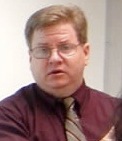
Shodor on the Move: People, Places, Things!
Many years ago, in a middle-school classroom in North Carolina, I saw a sign that said, simply, "Change is inevitable; improvement is by design." This could serve in many ways as a short history of Shodor over the last 17 years. We have seen many changes, but our goal has always been to improve math and science education with effective use of dynamic, interactive computing resources. Back in 1994, the country's fastest supercomputer cost more than 16 million dollars and was capable of running more than 100 million calculations per second. Now, Mac's and PC's can perform more than 1 billion calculations per second and cost less than a thousand dollars. Quite a change! And more changes are ahead, but each change will also be an opportunity for us to work together to improve Shodor's impact in service to education.
Things: With the increased use of mobile devices in education, Shodor is changing how it develops and delivers content to audiences. By the end of the summer, Shodor will roll out Math Flyer as our first venture into the mobile market. We'll let you know when it is available and how you can help support this work by downloading it from the App Store. More development will continue over the next year with new grants from the Rust Foundation and the National Science Foundation.
People: Shodor has grown over the years, from one surgically-repaired physicist and a neighborhood kid as an intern, to an exceptional staff of more than a dozen scientists, engineers, and educators leading a team of dozens of interns and apprentices. Three of our best who served at Shodor in this program are changing to start new phases of their lives. Valerie Gartland, one of our best workshop leaders and mentors, who has also worked on everything from High Performance Computing University to the international HiPOP website, will be working for MetaMetrics, which uses Shodor materials in their own work. Sam Leeman-Munk, who started as a Shodor intern in high school, then continued in the summers while attending Earlham College, and has worked fulltime since graduating last spring will be attending graduate school at NCSU full-time in the fall. Sam's work in parallel computing education and the iPad/iPhone programming project has been amazing. He also was one of the founding teachers of the Culbreth Computer Club in Chapel Hill. Andrew Fitz Gibbon, better known to us all as Fitz, will be starting in July at Amazon after more than a year being one of our "anything that anyone needs in any aspect of computing" mentors. Besides his work representing Shodor in the Educational Alliance for a Parallel Future, Fitz has been an instructor at all levels from kids to faculty. His new work will combine his interests in parallel computing, analyzing massive data sets, and modeling of collective social behavior.We wish Fitz, Sam, and Valerie all the best in their new challenges.
Places: More than 6 years ago, Shodor needed a new home and it was quite the struggle to find a place that wanted us at a price we could afford. By happy circumstance we were able to get a long-term lease in the Durham Centre with professional offices and a magnificent view. Downtown Durham has changed, with more and more businesses offering more and more dollars to locate in fewer and fewer available spaces. As a result, Shodor will have to move by the end of the summer as renewing our lease at "current market rates" is beyond our means. The good news is that by working with Tucker Shade of Tri-Properties, Shodor's board and staff are confident that we have found a good home for Shodor that will keep us in the Durham transportation zone and have the space that we need to be providing a safe mentoring environment. We are negotiating a budget that will ensure the new office will be custom fit for our students and staff to serve us for many years to come. We will let you know when details become final, and we hope we can count on your support to ensure the new facility has what is needed to remain at the front of the technology wave in education.
As you can see, indeed, change really is inevitable. And so we have designed for real improvement! A hearty thanks from all of us to each of you who have helped us along the way.
All the best,

Bob Panoff
Shodor Goes Mobile
Coming soon to an iPhone near you: Shodor excellence in education technology on Apple's ubiquitous and powerful mobile devices.
BY Rob Hochberg, Shodor Staff
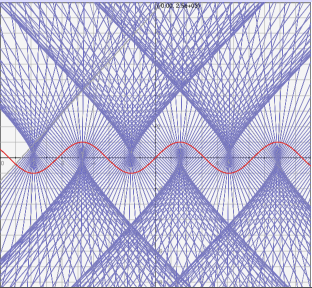
Shodor's reputation today as a resource for excellent digital tools for educators has sprung from the insistence that behind every new teaching gadget should be a justification of its effectiveness. Shodor adds a new activity to the website only after making sure that it is of high quality and of actual use to teachers. As a result, Shodor has one of the most widely-used educational websites on the Internet, and teachers make frequent use of Shodor activities in their classrooms.
A recent trend in some schools has been the introduction of Apple's mobile devices, such as the iPad and iPod Touch. With their beautiful, intuitive user interfaces and their innovative multi-touch technology, these products show great promise for education. As leaders in education technology, Shodor sees clearly the value of putting innovative software on Apple's innovative hardware. Due to technical incompatibilities, however, Shodor staff have to rebuild each of our activities from concept.
What better to start with than Math Flyer?
Shodor's first product for Apple devices is nearing completion, and will be available in the Apple store very soon. Math Flyer is a version of the flagship activity, Multi-Function Data Flyer. This app picks up where graphing calculators leave off. With Math Flyer, the user can plot a graph, and then manipulate all of the variables and constants in that graph and see how these changes affect the graph. For example, if a student plots "mx+b" within Math Flyer, he gets a graph of a straight line, but also two sliders labeled "m" and "b". When the student moves these sliders, the graph updates in real time, giving immediate feedback on the role of "m" and "b" in this function. By focusing on the graph and its equation, rather than on the mechanics of plotting a single line, the student more rapidly builds an intuition about the meaning of "m" and "b" in that equation.
But graphing lines is only the beginning. Math Flyer plots polynomials, all of the trig functions, exponentials, absolute value, square and sawtooth waves, and so much more. Full advantage is taken of the multi-touch interface so that the user can pan and zoom with the usual one- and two- finger gestures. The user can set his own independent variables, and even use multi-letter variables, so that "pos(time) = 100 + 7*time - time^2" would give a plot showing that the position varies quadratically with time, and the picture would show the parabolic flight of an object thrown off a cliff. The user can then modify "100" and "7" parameters to see the effect on the trajectory.
Of course, there's plenty more features the Math Flyer app has to offer! The user can take pictures of the graph which get saved into the device's photo album, suitable for mailing or printing. A trace feature keeps all plots on-screen as the user moves a slider. A table view shows numerical values of the graph, while the user gets complete control to display in decimal or fraction form. A rich collection of pre-set functions, on-device help, a built-in web browser for viewing related Shodor resources, and of course, full support for Apple's patented touch interface, allow students to tap, pinch and drag their way to mathematical fluency.
An educational revolution has long been ascribed to Apple's unique touch- based user interface. With Shodor's Math Flyer, it is finally a reality.
Summer Plans at Shodor
BY Theresa Meyer, Shodor Intern
Shodor is a hub of activity during the summer, offering workshops, apprenticeships, and internships to local middle school, high school, and undergraduate students in support of its mission to improve math and science education through the effective use of modeling and simulation technologies.
To satisfy their natural curiosities during time away from school this summer, a wide variety of workshops are available to middle and high school students interested in math, science, and technology. Workshops available to middle school students include Explorations in Engineering, Math Explorations, Forensics, Modeling Your World, Programming Concepts, and Web Design Skills. High school students may take similar workshops at more advanced levels including Explorations in Engineering, Programming Concepts, Web Design Skills, and Graphics and Visualization. At the summer's end, high school students may additionally participate in the Shodor Scholars Program, a two week long investigation of a variety of math, science and computational topics in great depth.
The SUCCEED apprenticeships are offered to high school students who are excited about science, technology, engineering, and mathematics (STEM) and who want to gain the experience they will need to pursue a technology- intensive career path. Apprentices work at Shodor for 6 weeks full-time over the summer and will participate in career and team building activities. Apprentices attend classes in math, problem solving, creative thinking, and also help Shodor staff with projects. Throughout the summer, apprentices have the opportunity to improve their math skills using computational tools, improve their writing skills by completing weekly journals to reflect on what they have learned, and improve their communication skills through regular discussions with their mentors and oral presentation of their work.
Interns will also be hard at work at Shodor this summer, working on everything from web development to teaching workshops. Internships at Shodor help students prepare to enter into computationally intensive scientific research fields through appropriate mentorships by active scientists.
Students of all ages and skills will have no trouble staying occupied as they work with Shodor this summer to learn and develop their skills, gain experience, and exhibit their expertise in science, math, and technology. For anyone who loves science, wants to expand their thinking, and wants to give their minds a workout, Shodor is the place to be this summer!
For more information on summer workshops or the apprentice program please visit www.shodor.org/calendar.
Shodor Partners With The Durham Bulls
BY Trey Clarke, Shodor Intern
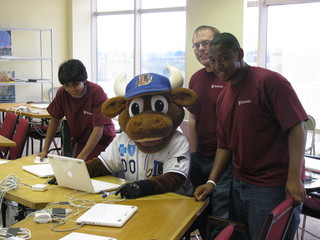
On the opening day for the Durham Bulls, Shodor staff attended the game, and through a booth set up on the concourse, informed fans about the educational workshops Shodor offers to middle and high school students this summer.
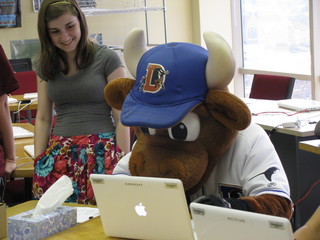
This partnership was continued on May 13th, when the Durham Bulls mascot, Wool E. Bull, made a guest appearance at the Shodor offices and actually "taught" Shodor students and staff about the importance of math and science in education. During Wool E. Bull's visit, Durham Bulls staff took video footage of Wool E. Bull teaching, as well as staff and student testimonials about their experiences at Shodor. This video was aired at a Durham Bulls game on May 17th. Shodor staff, interns, and guests were invited to enjoy the game and the video from the comfort of the Durham Chamber of Commerce suite!
Where Are They Now? Kirstin Riesbeck
BY Maya Gouw, Shodor Intern
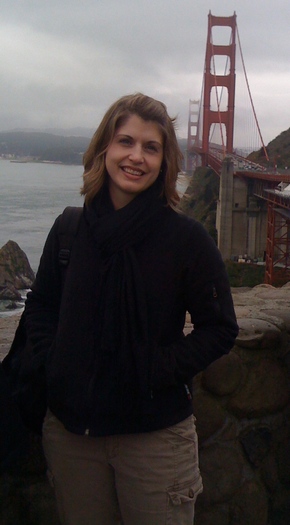
Nine years ago, Kirstin Riesbeck was a member of the Shodor family as part of the original leadership team of the National Computational Science Institute (NCSI). Looking back, Kirstin says she cherished her time at Shodor as a college intern. "It provided me wonderful opportunities and a strong foundation for what I do now," Kirstin proudly states.
Now, Kirstin works for the U.S. Coast Guard, a part of the Department of Homeland Security. She was selected for the Senior Service program for civilians, and is currently attending the Naval War College. She plans to graduate June of 2011. In her spare time Kirstin enjoys running and traveling.
Since her farewell from Shodor, Kirstin has continued her journey of computational science... Through the Coast Guard Kirstin has been working with scientists developing models that rely greatly on some of the skills she had previously learned at Shodor. "While I have not personally developed these models, it has been extremely valuable to understand computational science in order to be able to work with the scientists in order to develop policy related to these issues," she notes.
Dr. Panoff Receives Michael C. Jackson Award
BY Paul Kovach, Shodor Intern
Each spring, the North Carolina Science Leadership Association (NCSLA) presents the Michael C. Jackson Distinguished Service Award to the person who has "performed a great service to science education in North Carolina." In 2011, the NCSLA chose the recipient of the award to be Shodor's own Dr. Robert M. Panoff.
The award, sponsored by Fisher Scientific, is given in honor of North Carolina native Michael Conoly Jackson who, along with many other accomplishments, worked to create a cohesive organization where science educators could meet, plan, and organize their educational efforts. Dr. Panoff and The Shodor Education Foundation fall squarely in line with the ideals of Mr. Jackson and the NCSLA. With Dr. Panoff's devotion to "training students at all levels; training their teachers; and coordinating the construction of one of the Internet's most widely-used computational science resources for education," it is easy to see why he is being honored for promoting the cause of quality science instruction, a mission of the NCSLA.
These resources, encompassed by The Computational Science Education Reference Desk (CSERD), provide "well-designed, interactive, scientifically and mathematically valid activities that... students need in order to understand concepts that are difficult to represent in a static textbook," says Susan Ragan, Project Director of the Maryland Virtual High School Project and NCSI alumna.
Along with the award itself, Dr. Panoff also received a $500 gift certificate to Fisher Scientific, which he says will, "provide useful resources such as DNA samples and modeling kits for summer workshops on forensics and mathematical modeling."
Shodor Excites Students About Science and Math at Fuller Elementary School
BY Paris Fears, Shodor Intern
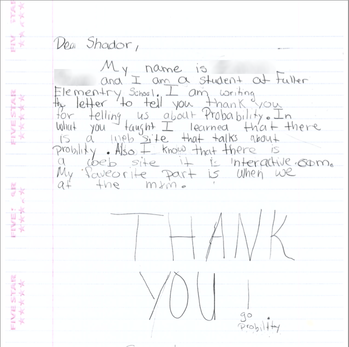
Shodor strives to get students engaged, excited, interacting with one another, and ultimately learning something new about math, science, or technology. Through outreach Shodor tries to not only advertise the services offered to students, but also to improve how students view math and science. The first step is getting students inspired; the second is teaching them how to implement learning into their everyday life.
For over four years, Shodor has been visiting Fuller GT Magnet Elementary School in Raleigh, NC. Recently, the elementary school held a Science Enrichment day, and Shodor was just one of the many exciting presenters. Valerie Gartland, with the help of interns Vadim Khazan and Di Lu, taught and reviewed experimental and theoretical probability to four fourth grade classes. Throughout the lesson Valerie was able to incorporate hands-on activities using computer modeling to show students graphs and other probability related activities such as the Adjustable Spinner applet.
After returning from the workshop Valerie said, "The students were very enthusiastic about the class. They loved having the chance to use the computers, and some even asked about the workshops here at Shodor." After the workshop, some of the classes sent thank you letters to show their gratitude for the lesson. One student wrote, "I really really appreciate you coming to teach us about probability, and I would like if you all would come back again." Another student said, "Thank you so much for teaching me about probability."
Through outreach efforts Shodor is creating future mathematicians and scientists. Fuller Elementary is only one of the many elementary schools that Shodor partners with, and it is through these partnerships that Shodor will continue to strike and intrigue students in the classroom.
Shodor Student Wins National Competition
BY Ben Ivey, Shodor Intern
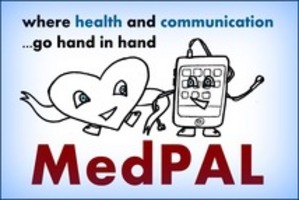
Shodor intern Ada Taylor participated in the Conrad Spirit of Innovation Competition with her group Unisecurity from the NC School of Science and Math, taking first place in the competition. Held at the NASA-Ames Research Center, the competition was intended to develop mobile applications based in security.
Unisecurity's winning Android application is called MedPAL and is intended to work in conjunction with Bluetooth heart rate monitors to look for user health emergencies. If such an emergency is detected, the application automatically notifies specific contacts and/or a call center with patient and situational information and GPS data. Also, the phone gives an auditory alert and displays pertinent medical information on the screen in case of emergency.
Ada's team has received a grant from winning the competition of $5,000 to continue development, as well as promotional resources.